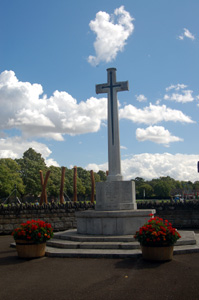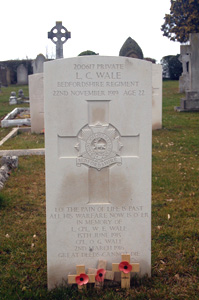Deaths of Sandy Men in 1918 and 1919

Sandy war memorial August 2010
The Sandy war memorial stands next to the recreation ground on Bedford Road. It contains 126 names of Sandy men killed in the First World War. The size of Sandy, including its hamlets was 3,377 in the 1911 census. Of these men 53 were killed serving with the Bedfordshire Regiment. Bedfordshire and Luton Archives and Records Service has the war diaries of each of the battalions of the regiment to see active service. The numbers of Sandy dead for the Regiment each year are as follows:
- 1914: 4
- 1915: 6
- 1916: 10
- 1917: 22
- 1918: 10
- 1919: 1
The numbers killed with each battalion were as follows:
- 1st Battalion: 19
- 2nd Battalion: 11
- 4th Battalion: 4
- 1st/5th Battalion: 2
- 6th Battalion: 3
- 7th Battalion: 11
- 8th Battalion: 3
The first casualty from Sandy serving with the Bedfords in 1918 occurred on 22nd January when Private William Merryweather died. He had been born in Haslemere [Surrey], but was living in Sandy at the time of his enlistment. At that time the battalion were alternating short spells in the front line in front of Houthoulst Forest, north-east of Ypres with training behind the lines. On the day of Private Merryweather's death the war diary simply says: "Short route march and foot rubbing drill", the latter being necessary to prevent a condition known as trench foot, a kind of foot rot brought on by standing around in cold water in trenches. William was not killed in action, nor did he die of wounds, so he must have either had an accident or died of illness; at that time of year the latter seems more likely, perhaps a cold which turned into pneumonia.
On 21st March the Germans launched a huge attack on the British Army in France. Having knocked Russia out of the war at the end of 1917 Germany was able to bring all her troops from the Eastern Front and add them to those on the Western Front. At the same time British armies had shrunk in size. Due to the terribly costly battles of 1916 and 1917 the Prime Minister, David Lloyd George was unwilling to send any more young men to be wasted in pointless offensives. This meant that the strength of the army was cut by about a quarter. At the same time the army had to take over a greater part of the front line from the French army which was close to collapse after a series of mutinies. A longer front held by less men being attacked by greatly superior numbers of fresh German troops was a recipe for disaster and the British were bundled back fifty miles an unheard of distance in terms of First World War offensives.
On the third day of the German offensive, 23rd March, Sandy resident Corporal Oscar George Wale of the 7th Battalion was killed in action. Oscar was the son of Alma and Eliza of The Avenue. This means that he was the brother of William John Wale, killed with the 2nd Battalion in 1915. On that day the 7th Battalion war diary reads: "Morning very misty.
- 7a. m. Enemy attacked again and effected crossing on right and left flanks of Brigade front.
- 10 a. m. owing to flanks being turned order received from brigade to retire to ridge in front of Faillouel.
- 1 p. m. Retirement successfully carried out & position taken up
- 4 p. m. Position in front of Faillouel became untenable owing to high ground of left flank falling into hands of enemy. Order therefore received to fall back to high ground West of village.
- 7 p. m. Received orders to rendezvous Battalion and march back to Caillouel. Details heavily engaged in fighting near Rouez Camp, finally falling back on Villequier-Aumont".
Details were small groups of men detached to perform other tasks such as loading or unloading. They had been separated from the parent battalion since before the German attack. Corporal Wale has no known grave. Perhaps he was killed as the unit fell back and the Germans, not wanting to slow their advance simply left the body where it fell. He is commemorated on the Pozieres Memorial to the Missing.
On 7th April Lance Corporal Ernest Wagstaff, born and living in Sandy, was killed in action with 4th Battalion. The previous day the battalion had been attacked but had managed to hold their position. The diary for the 7th simply says: "Battalion relieved in line by Hood Battalion, 7 other ranks killed 49 other ranks wounded". This suggests the battalion had come under heavy shelling. Lance Corporal Wagstaff is buried in Mesnil Communal Cemetery Extension, he was formerly a member of the Bedfordshire Yeomanry, a militia cavalry unit.
Another 4th Battalion soldier, Private Frank Baldrey, again born and living in Sandy, was killed on 1st June. He was the son of William and Elizabeth of the High Street and was 24 years old. He is also buried in Mesnil Communal Cemetery Extension. The battalion war diary simply says: "Battalion relieved 1st Artists Rifles in front line. 2 other ranks wounded". This was at Aveluy Wood, on the Somme, ironically, very close to Beaucourt which they had captured in November 1916. Perhaps Private Baldrey was initially wounded but died before he could be evacuated.
By August 1918 the tide of the war had turned. The 21st March German offensive, and other later offensives of theirs, launched at other points, had petered out. Then, on 8th August an offensive involving French, British, Canadian, Australian and American forces got underway at Amiens. This was the start of the Hundred Days Campaign, a prolonged offensive that ended in the Armistice of 11th November.
On 29th August Private Stephen Garner of 2nd Battalion died. He had been born in Ravensden but was living at Beeston Green when he enlisted. He is buried in Rethel French National Cemetery. Commonwealth soldiers buried here were all prisoners of war who died in German hands and were buried in German cemeteries as Rethel was in German hands until a few days before the Armistice.
Another 2nd Battalion soldier, Sandy born and resident Private Cyril Wilfred Andrews died of wounds on 18th September. He was the third resident of Pyms Cottages to die with the Bedfords in the war. He is buried in Doingt Communal Cemetery Extension. He, like Ernest Wagstaff, had formerly been a member of the Bedfordshire Yeomanry. That day the battalion had attacked Ronssoy and perhaps Private Andrews was wounded during the action, or on the previous day in which the battalion had entered the front line.
A third soldier from 2nd Battalion, Lance Sergeant Arthur Gentle died of wounds at home on 18th October 1918. To have been invalided home indicates that his wound had been a bad one but there is no way of knowing how or where he received it. He had been born in Beeston and was living in Bedford when he enlisted. Nevertheless, he is buried in Sandy Cemetery.
Two soldiers from 1st Battalion died on 23rd October. The battalion war diary for the day reads: "At 03.20 hours Bedfords and Cheshires went over the top to the attack but were held up on the right by machine gun fire. Made good later on capturing the village of Beaurain. Relieved during the day and returned to Billets in Caudry". 19 members of the battalion were killed and 114 wounded. Sergeant Reuben Jefferies was killed in action. He was clearly a brave man, having won the Distinguished Conduct Medal, second only to the Victoria Cross for other ranks. He had been born in Everton but was living in Sandy at the time of his enlistment. Sadly, he has no known grave and is commemorated on the Vis-en-Artois Memorial. He may have been hit by a shell. On the same day Private Herbert John Dean, Sandy born and resident, died of wounds. His mother was Rose Franklin of 7 George Town, the same address as William and Lucy Franklin whose son George William was killed in 1915. He was 23 years old and is buried in Awoingt British Cemetery in which 38th, 45th and 59th Casualty Clearing Stations buried their dead. He may have received his wound in that day's attack or on the previous day when the Germans put down a barrage on the battalion's positions.
The last Sandy man to died with the Bedfords during the war was Sandy born and resident Edward Lawson who died on 8th November. As he was not killed in action and did not die of wounds he must have had an accident or died of disease. The latter seems most likely and one is tempted to think in terms of the Spanish Flu which raged across the World in 1918. He is buried in Caudry British Cemetery
The last Sandy death is the third of the Wale brothers, Leonard Cecil of the 1st/5th Battalion who died at home on 22nd November 1919 aged 22 and is buried in Sandy Cemetery. He may have died of a wound received, or from the effects of gas or from some disease picked up during his service in Egypt and Palestine. The fact that he has a Commonwealth War Graves Commission headstone shows that it was acknowledged that his death was as a direct result of his active service. It is touching that is two brothers are also commemorated on his headstone
WE WILL REMEMBER THEM
 Leonard Wale's headstone March 2010
Leonard Wale's headstone March 2010